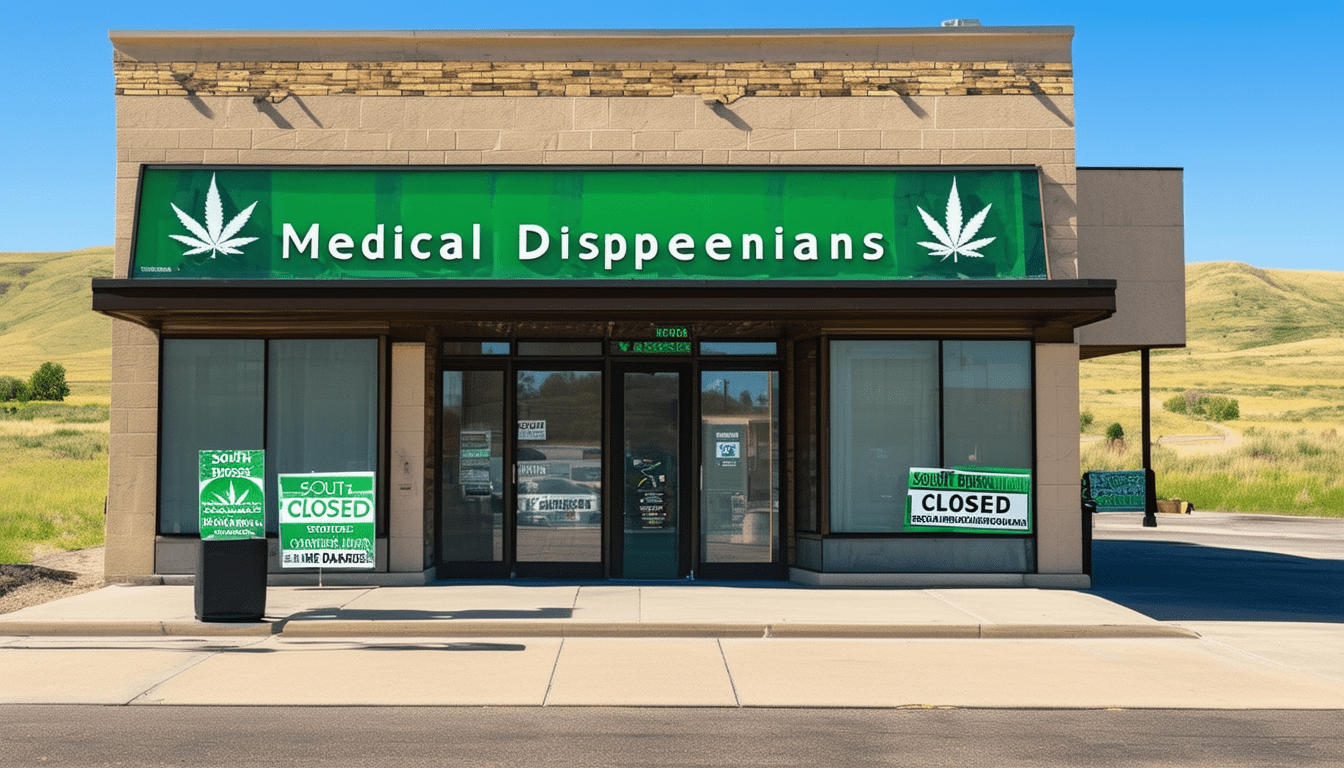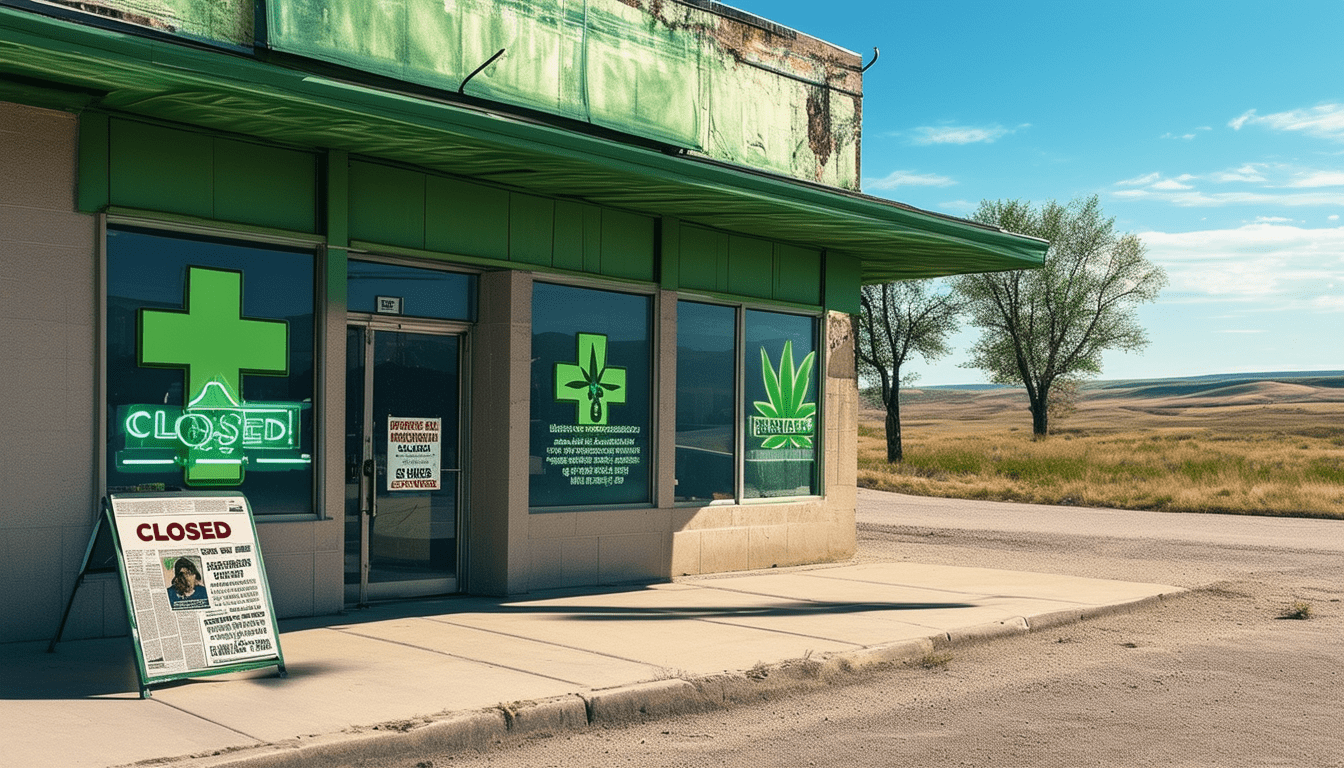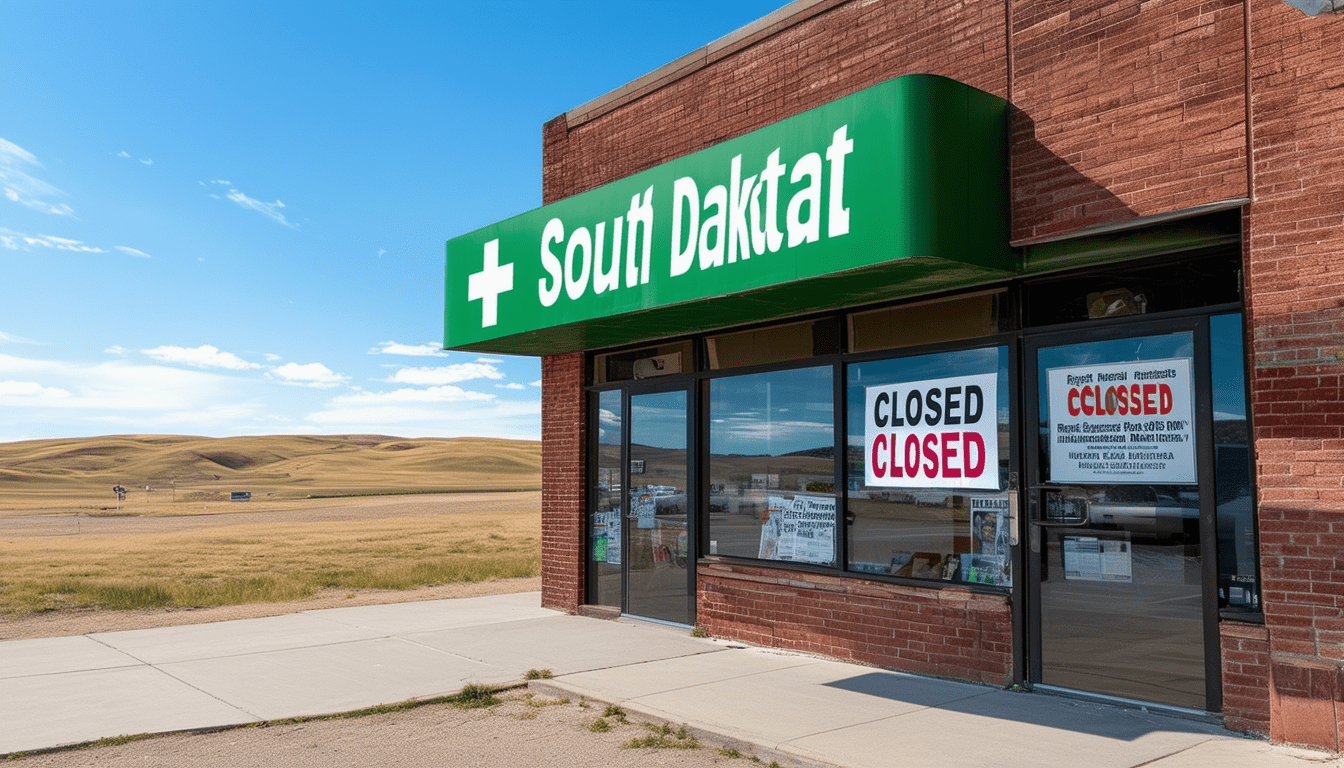South Dakota’s Medical Marijuana Dispensaries Face Closure Following Voter Rejection of Recreational Cannabis Legalization
|
IN BRIEF
|
The recent voter rejection of recreational cannabis legalization in South Dakota has triggered significant consequences for the state’s medical marijuana dispensaries. As businesses grapple with an increasingly difficult market, the repercussions are being felt particularly by smaller dispensaries and cultivators. The swift expansion of dispensaries, combined with a decline in patient cardholders and regulatory burdens, has led to an unsettling trend of closures, raising concerns about the future of medical cannabis access in the region.

The recent decision by South Dakota voters to reject the legalization of recreational cannabis has sent shockwaves through the state’s medical marijuana market. As dispensaries grapple with increased competition and falling patient cardholder numbers, many are finding it increasingly difficult to remain viable. Dispensaries that once thrived in the budding industry are now facing closures, as they are unable to adapt to the rapidly changing legal and economic landscape.
Understanding the Impact of Voter Decisions
The rejection of Initiated Measure 29 by a significant margin has left advocates and businesses reeling. Many medical cannabis dispensaries in South Dakota had pinned their hopes on the legalization of recreational marijuana, believing it would boost their sales and expand their customer base. However, with the measure’s defeat, dispensaries are now struggling with oversaturation in the market and diminishing revenue.
A Decline in Patient Cardholders
One of the primary issues facing dispensaries is the declining number of patient cardholders. Reports indicate that the number of registered medical cannabis patients has dropped from nearly 14,000 to under 12,000 in a short span. This decrease in clientele has strained dispensaries like Unity Rd., which opened shortly after medical sales became legal. B.J. Olson, the owner, noted that as new dispensaries entered the market, competition led to a downward spiral in pricing and profitability.
Regulatory Challenges and Market Saturation
In addition to falling patient numbers, dispensaries are also hampered by regulatory challenges. The state’s strict advertising rules and rising costs for licensing and compliance have made it difficult for small dispensaries to survive. Olson shared that he was warned about social media posts that seemed too promotional, further complicating his efforts to reach potential patients.
Moreover, many dispensaries are facing a saturated market. With numerous shops opening in areas like Sioux Falls, many experienced dispensary owners are finding that the profit margins are shrinking as they compete for a limited number of customers.
Financial Strain and Business Closures
As a result of these pressures, there have been multiple closures of dispensaries across South Dakota. Reports have surfaced indicating that at least eight dispensary licenses were lost over the past winter, signaling a troubling trend for the industry. Joe Stavig, CFO of Dakota Herb’s dispensary, mentioned witnessing smaller dispensaries go out of business due to the financial toll of decreased patient numbers and the inability to compete with alternative markets.
The Rise of Alternative Markets
Another challenge for medical dispensaries is the growing availability of hemp-derived products, which have captivated many potential medical cannabis users. Smoke shops have seized on a legal loophole to sell products that mimic the effects of cannabis, further luring away potential patients who might otherwise seek out medical marijuana.
Alan Welsh from Dakota Herb pointed out that standalone dispensaries are struggling to compete with these establishments that are not burdened by the same strict regulations as medical dispensaries. This disparity only complicates matters for those who are committed to providing well-regulated medical cannabis to patients.
Looking Ahead: Hope and Uncertainty
While the landscape remains grim, there are some sparks of hope among dispensary owners. Stavig mentioned that some individuals who had delayed obtaining their medical weed cards due to the hope of recreational legalization may now reconsider, potentially replenishing patient numbers. Furthermore, there are calls to expand the list of qualifying conditions for medical cards, which could provide relief for dispensaries.
However, the outlook remains uncertain. Roy Nielsen, owner of cultivation facilities and dispensaries, expressed his concern about navigating a business environment that changes rapidly and often unfavorably. As they brace for potential consolidations within the industry, many are left wondering if South Dakota will create a more accommodating framework for medical marijuana in the near future.
The rejection of recreational legalization and the challenges within the medical market spotlight the complexities of the cannabis industry in South Dakota, leaving many dispensaries at the brink of closure as they adapt to a shifting regulatory and economic environment.
Impact of Voter Rejection on Medical Marijuana Dispensaries
| Factors | Impact on Dispensaries |
| Competition Increase | Smaller dispensaries struggle with reduced sales and profitability. |
| Decline in Patient Numbers | Cardholders decreased from nearly 14,000 to under 12,000. |
| Regulatory Challenges | Strict rules hinder marketing and operations, leading to increased costs. |
| Failed Recreational Legalization | Closure of dispensaries expected as potential market expansion didn’t occur. |
| Taxation Issues | High compliance costs and tax burdens weigh heavily on financial sustainability. |
| Market Saturation | Oversaturated market diminishes revenue potential for existing dispensaries. |
| Availability of Alternative Products | Increased competition from non-regulated hemp-derived products affects medical marijuana sales. |

Several medical marijuana dispensaries in South Dakota are confronting imminent closure after voters rejected the legalization of recreational cannabis. This decision has triggered a chain reaction in the local cannabis industry, resulting in reduced revenues, increased competition, and challenging regulatory environments that threaten the viability of small dispensaries.
Impact of the Voter Rejection
The recent ballot measure, Initiated Measure 29, aimed to legalize recreational cannabis but was decisively rejected by 55.5% of South Dakota voters. This outcome has led to significant concerns among existing dispensaries, particularly those that primarily serve medical marijuana patients. The vote not only halted plans for expansion but also intensified fears about market saturation and competition that are already adversely affecting smaller businesses.
Struggling Dispensaries
Dispensary owners are noticeably disheartened. B.J. Olson, the owner of Unity Rd. in Hartford, saw his business flourish initially after the legalization of medical marijuana. However, as new competitors entered the market, his revenue dwindled. “Every time a new dispensary opened, it would be a little less and a little less,” Olson lamented, noting that the trend ultimately resulted in competitive pricing that strained his profits.
The Regulatory Challenge
The challenges faced by dispensaries extend beyond competition. The regulatory framework imposed by the South Dakota government adds another layer of difficulty. Dispensaries cannot engage in standard marketing practices, limiting their ability to attract new patients. The state changes regulations frequently, necessitating specialized accountants and legal advice, all of which financially burdens small operations.
Declining Patient Numbers
In tandem with the market saturation, the number of medical marijuana cardholders has also plummeted, dropping from nearly 14,000 to fewer than 12,000. This decline further threatens dispensaries’ sustainability, as fewer patients translate directly to lower sales and revenue across the industry. Joe Stavig, CFO of Dakota Herb, states, “What we’re seeing is some of these smaller dispensaries closing down, and even potentially some smaller cultivators shutting down.” The situation has raised alarm bells within the cannabis community regarding the longevity of medical marijuana access in South Dakota.
Competition from Alternative Products
Another significant factor contributing to the strife of medical dispensaries is the emergence of legal products derived from hemp. These alternatives offer similar effects to cannabis, posing direct competition to regulated cannabis products. Alan Welsh of Dakota Herb indicates that standalone dispensaries struggle to compete against smoke shops selling hemp-derived products that can legally circumvent the restrictions faced by cannabis businesses.
Future Outlook
Despite the bleak landscape following the ballot defeat, some dispensary owners remain hopeful for future improvements. Advocates are pushing for an expansion of qualifying conditions for medical marijuana cards, as well as better regulatory frameworks that can stabilize the market. However, achieving substantial reforms may hinge on overcoming entrenched legislative and bureaucratic hurdles.
Key Factors Influencing Dispensary Closures
- Surge in Competition: Rapid increase in dispensaries leading to price wars.
- Declining Patient Cardholders: Significant drop from nearly 14,000 to below 12,000.
- Regulatory Challenges: Strict advertising rules and high compliance costs negatively impacting operations.
- Market Saturation: Oversupply of dispensaries overwhelming small businesses.
- Alternative Products: Proliferation of hemp-derived products diverting customers.
- Pending Legalization: Failed Initiated Measure 29 left many dispensaries without a viable path forward.
- Tax Burdens: Inability to deduct common business expenses further straining finances.
Understanding the Rejection of Recreational Cannabis in South Dakota
The recent rejection of recreational cannabis legalization in South Dakota has had significant ramifications for the state’s medical marijuana dispensaries. Many establishments are struggling to survive amid increasing competition, regulatory challenges, and a declining number of patient cardholders. The closure of several dispensaries, including notable ones like Unity Rd., underscores the precarious position of the industry and raises concerns about the future of medical cannabis in the region. This article highlights key recommendations to help medical marijuana dispensaries navigate this challenging landscape.
Adapting to Market Competition
With the wave of closures prompted by competition and reduced revenues, dispensaries must adopt innovative strategies to differentiate themselves in a saturated market. One approach is to focus on branding and customer experience. By creating a unique brand identity that emphasizes quality, customer service, and community engagement, dispensaries can establish loyal customer bases.
Additionally, dispensaries should consider forming strategic alliances with local healthcare providers. Partnering with medical professionals can facilitate better patient education and potentially increase patient referrals. Offering services such as wellness workshops or informational sessions can also enhance the patient experience and attract new clientele.
Improving Regulatory Compliance
The stringent regulations surrounding medical cannabis in South Dakota have proven to be a double-edged sword. While they ensure patient safety, they also impose significant burdens on dispensaries. Therefore, it is imperative for dispensaries to invest in compliance training and resources. Hiring a dedicated compliance officer can help ensure that all regulations are adhered to and that the dispensary is prepared for potential audits or inspections.
Furthermore, advocating for more reasonable regulations through industry groups can help address disproportionate burdens on medical cannabis businesses. Engaging with policymakers can provide insights into the challenges faced by dispensaries and foster legislative changes that support the industry’s growth instead of hindering it.
Enhancing Patient Outreach and Education
The decline in medical cardholders indicates a need for improved outreach and education efforts. Dispensaries should proactively engage potential patients by offering educational resources about the benefits and uses of medical cannabis. Hosting community events or info sessions can demystify medical cannabis and encourage individuals to consider obtaining their medical cards.
Using social media platforms effectively can amplify these outreach efforts. Creating informative content about patient testimonials, disease management, and the medical benefits of cannabis can help dispel myths and encourage potential patients to pursue legal access.
Innovating Product Offerings
To stay competitive, dispensaries must continually innovate their product offerings. This includes expanding the range of products available, such as offering hemp-derived products that comply with current regulations. Diversification can attract various customer demographics and encourage repeat business.
Moreover, developing unique in-house products or exclusive partnerships with local cultivators can help dispensaries stand out. Providing tailored experiences with personalization in service delivery can significantly enhance customer loyalty.
Considering Financial Stability and Growth Strategies
The financial strain on dispensaries can be alleviated by exploring diverse funding options. Pursuing grants or state-supported financing initiatives might reduce initial operational costs. Additionally, establishing a clear business plan focused on short-term financial stability while also setting long-term growth goals is crucial.
Dispensaries should regularly review their financial health and adjust business strategies accordingly. This could involve evaluating pricing structures to remain competitive, monitoring expenses, and seeking ways to reduce overhead costs.
FAQ on South Dakota’s Medical Marijuana Dispensaries and Recent Developments
What has happened to South Dakota’s medical marijuana dispensaries? Several medical marijuana dispensaries in South Dakota are facing closures following the recent voter rejection of recreational cannabis legalization.
Why are dispensaries closing? The closures are primarily due to increased competition, a decline in patient cardholders, and regulatory challenges that have made it difficult for smaller dispensaries to remain profitable.
How many dispensaries have closed? At least eight dispensaries have closed, with more expected to follow as the market continues to struggle due to oversaturation and declining patient numbers.
What impact did the rejection of Initiated Measure 29 have? The rejection of Measure 29, which aimed to legalize recreational marijuana, has led to a sense of uncertainty in the market, prompting some dispensaries to close their doors.
What are the current trends in patient cardholder numbers? The number of patient cardholders in South Dakota has decreased significantly, falling from nearly 14,000 last winter to fewer than 12,000 currently.
How are regulations affecting dispensary operations? Dispensaries face strict regulations that limit advertising and increase compliance costs, making it challenging for them to maintain profitability.
Are there concerns about alternative cannabis products? Yes, the rise of hemp-derived products sold in smoke shops has created competition for standalone dispensaries, which are struggling to differentiate themselves from these alternative products.
What are the potential future implications for dispensary owners? Owners are concerned about continued market instability and regulatory challenges, which may lead to further closures and consolidations in the industry.





Post Comment